Sixty-years ago this month, the United States launched a primitive two-stage rocket from an obscure site situated on Florida’s eastern coast. The rocket was the Army’s Bumper-WAC No. 8. The then little-known launch location has since become synonymous with American aerospace achievement. We know it today as Cape Canaveral.
The Bumper Program was a United States Army effort to reach flight altitudes and velocities never before achieved by a rocket vehicle. The name “Bumper” was derived from the fact that the lower stage would act to “bump” the upper stage to higher altitude and velocity than it (i.e., the upper stage) was able to achieve on its own.
The Bumper two-stage configuration consisted of a V-2 booster and a WAC Corporal upper stage. The V-2′s had been captured from Germany following World War II while the WAC Corporal was a single stage American sounding rocket. The launch stack measured 62 feet in length and weighed around 28,000 pounds.
From a propulsion standpoint, the V-2 booster generated 60,000 pounds of thrust with a burn time of 70 seconds. The WAC Corporal rocket motor produced 1,500 pounds of thrust and had a burn time of 47 seconds.
The first Bumper-WAC shots took place at White Sands Proving Ground (WSPG) in New Mexico. The first six (6) flights were dedicated to achieving maximum altitude. Indeed, Bumper-WAC No. 5 flew to an altitude of 250 miles on Thursday, 24 February 1949.
WSPG could not be used for the last two (2) flights which required the Bumper-WAC vehicle to remain within the atmosphere. A larger range was required to handle these missions which involved a significant amount of essentially horizontal flight. Looking beyond Bumper, it was clear that future programs would also require a much larger test range as well.
After considering a number of geographical locations within the US, the new Long Range Proving Ground (LRPG) was ultimately established in the state of Florida. The LRPG locale was hot, bug-infested and covered with sand dunes and scrub palmetto. However, the LRPG was also immediately adjacent to the Atlantic Ocean which provided a vast region over which test rockets could be safely flown.
Bumper-WAC No. 7 was supposed to be the first rocket fired from the LRPG. However, Bumper-WAC No. 8 got that honor when No. 7 experienced a glitch on the pad. No. 8 was fired at 13:29 UTC on Monday, 24 July 1950. The mission failed when the rocket motor of the WAC upper stage did not ignite.
On Saturday, 29 July 1950, Bumper-WAC No. 7 was launched from the LRPG. The mission was entirely successful. The WAC upper stage burned-out at Mach 9 and flew 150 miles downrange. The maximum sustained velocity within the atmosphere was more than 3,200 mph – a record for the time.
While the Bumper Program would fade into history, the LRPG did not. History records that the fledging test facility would develop into America’s preeminent launch complex. The military services would grow both our Nation’s missile defense and space launch vehicle capabilites there. Later, NASA would come on the scene and send astronauts first into Earth orbit and then to the Moon.
Cape Canaveral now operates in a season of decline relative to our national space effort. The fabled Space Shuttle will soon be retired. The CEV Program is slated for cancelation, leaving our country without either a national manned launch vehicle or spacecraft. Very soon, we will not even be able to go to and from our own space station. The prevailing “wisdom” is that private industry will solely provide access to space in the future. And such is to be accomplished without any national system being available as a back-up.
That we as a nation find ourselves in the predicament outlined above, is at once ironic and obscene. However, this is America and we are Americans. And, despite determined and increasing assaults from without and from within, we are still a land of liberty and opportunity. We can chose a better path.
Whether Cape Canaveral has seen its best days or if those that lie ahead will be better still, it is up to the citizens of the United States to determine. The responsibility and obligation to do so can neither be evaded nor avoided. If we chose rightly, Cape Canaveral’s, and indeed our beloved country’s, best days await in the future.
To both we say with deepest sentiment: “Long may you run.”

